Feeding Kiddos: Healthy Habits from the Beginning
Post By Olivia Blodgett, Registered Dietitian
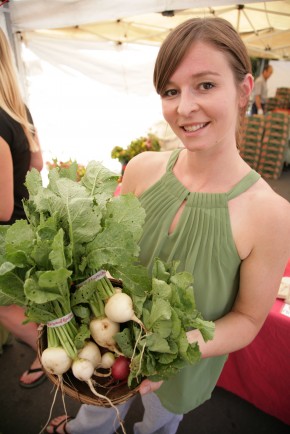
My career as a dietitian started 11 years ago at a WIC (Women’s Infants and Children clinic) counseling pregnant and postpartum women and their small children. My subsequent career choice led me to a pediatric obesity clinic in Kentucky. Throughout these early years of my career I counseled hundreds of families on how to feed kids. In addition, I taught cooking classes to kids of all ages, while the parents sat in a room with a psychologist discussing how to model appropriate eating behavior. I’ve seen the whole spectrum, from pregnant women who for the first time in their lives were taking an interest in nutrition because they wanted only the best for their child from the start, to the parents with the morbidly obese child, who brought McDonald’s into the appointment and proceeded to blame the child for eating too much.
There is SO MUCH that goes into feeding kids. I am trying to keep this blog post to a readable and concise length, but I could literally talk about this topic for hours. Following nutrition guidelines are only a small piece of what’s important. Teaching and promoting healthy eating behaviors is what it all boils down to and once that is accomplished, the rest falls into place.
The expert in feeding children is a woman named Ellyn Sattyr and I first read her books when I was in grad school. I remember thinking that she made feeding kids sound simpler than I imagined it actually was. I believed in her teachings and repeated them to my clients, although I knew I was limited in my ability to really empathize and understand the challenges because I hadn’t actually fed a child myself. Now that I have a beautiful 18 month old daughter with very strong opinions, I am working through some of these feeding challenges in my own kitchen. I was correct, feeding kids is way more difficult than I could have imagined but I now believe in her guidelines more than ever. Her guidelines are very simple but putting them into practice may not be, depending on your kiddo. Her Division of Responsibility of Feeding is displayed in the image below. I have been referring to this religiously as a reassurance that I am doing the right thing and it is paying off tremendously.
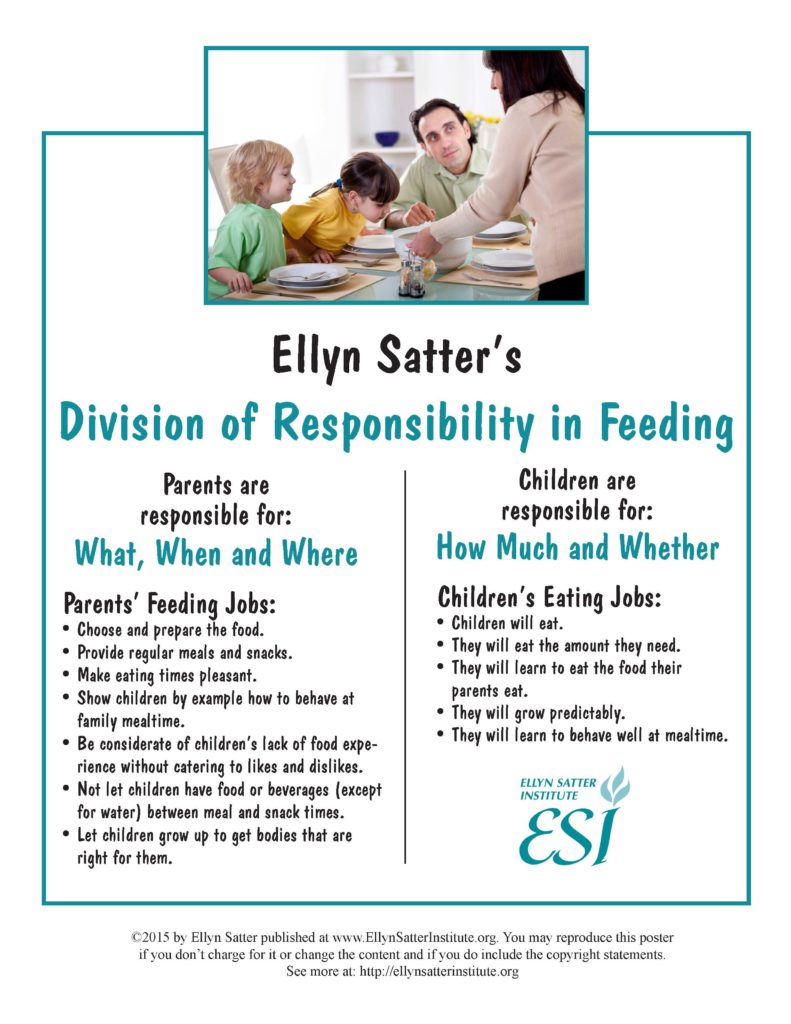
In a nutshell, the parent is responsible for providing food (ideally healthy options) and the child can chose how much, whether and what she eats. Once I was able to really understand my role as a parent, so much of the stress was relieved. My main job is to provide her with food and once I do that, the rest is up to her. Whether or not she eats is her decision, it is not my job to make sure that she does. I am providing her with food and if she is truly hungry eventually she will learn to eat what I am offering.
Although, a lot of the pressure was removed from my role as a parent, this process is still not an easy one to follow. Being the naive new mom that I was, I imagined that my child would just love every lentil/curry/vegetable/etc. dish that I made because that’s what was on her plate and I thought it tasted delicious. Some kids are more open to different foods and flavors than others but the more common situation is the opposite: resistance to trying new foods and a tendency to want simple/sweet carbs and dairy.
Right off the bat my daughter starting refusing food and often meals because she didn’t like the taste that hit her mouth. She just didn’t seem very interested in food as a whole, no matter how I prepared it. In the beginning, I was so worried that my child wasn’t getting enough. Compared to recommended portion sizes and caloric needs for kids, she was way below the guidelines and she had a history of concerning slow weight gain. My instinct was to push (i.e. pressure) her to eat, to offer her anything I knew she would eat if she refused the meal (i.e. fruit and cheese), and to fill her up on milk because at least it was calorie dense. I had to keep reminding myself of The Division of Responsibility and trust in the process. I knew that if I gave into giving her what she wanted I was setting myself up for years of short-order cooking and meal time battles. The way we handled it was really difficult, heartbreaking and frustrating in the short term but I knew in my heart it was the right way.
The plan was to provide my daughter with a plate of what we were eating at meal time, but to make sure to include one item that I knew she liked on the plate (this is one of Sattyr’s recommendations that I found enormously helpful). If she didn’t want anything, then that was ok. But if she asked for a snack later (which she always did), her only options were what was on her dinner plate. She really didn’t like this. We spent many tearful nights of her asking for a snack and me repeatedly pulling the dinner plate back out of the fridge only to result in more screaming and crying. This felt awful, it felt mean and cold. But again, I knew in my heart this was right. I wasn’t starving her. I was offering her a wide variety of food (some of it that I even KNEW she liked!) but I was not letting her chose what she wanted beyond that. I remember the worst night of this (probably about a week into working on the behavior) when she must have asked somewhere around 10 times for a snack and I pulled her dinner plate with cauliflower gnocchi in kale sauce out of the fridge about 10 times. On the 10th time, she decided to eat it. That meal is now the one meal I know she will always eat and enjoy. The first week was brutal but this was just the glimmer of hope I needed to know that what I was doing was working.
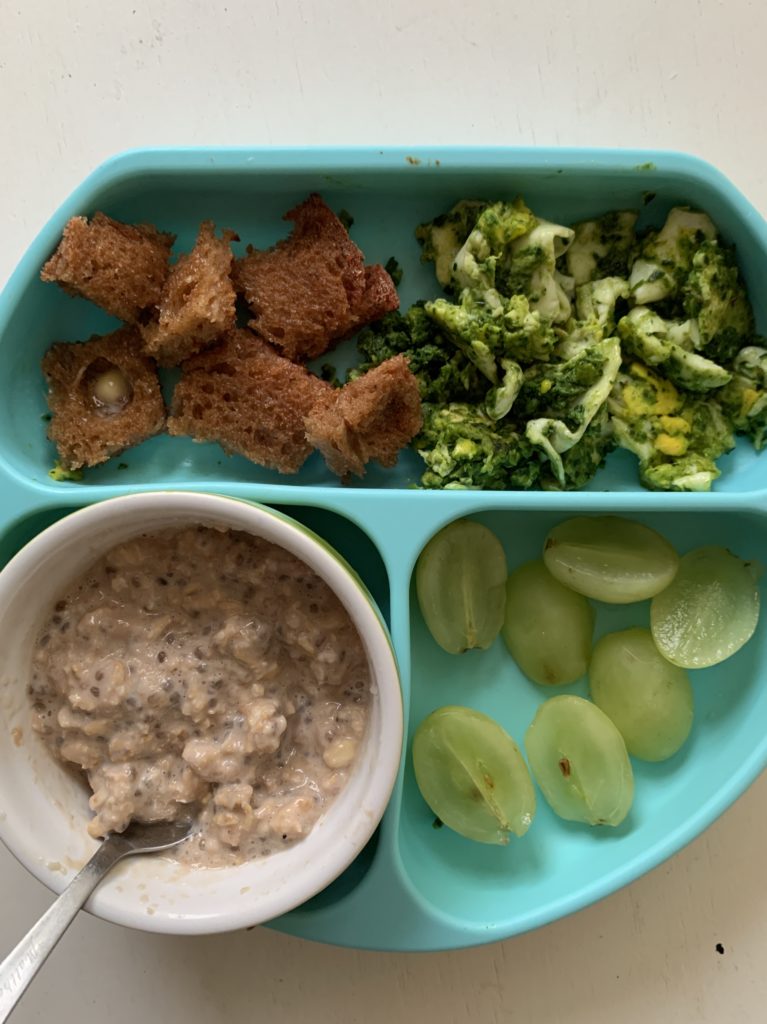
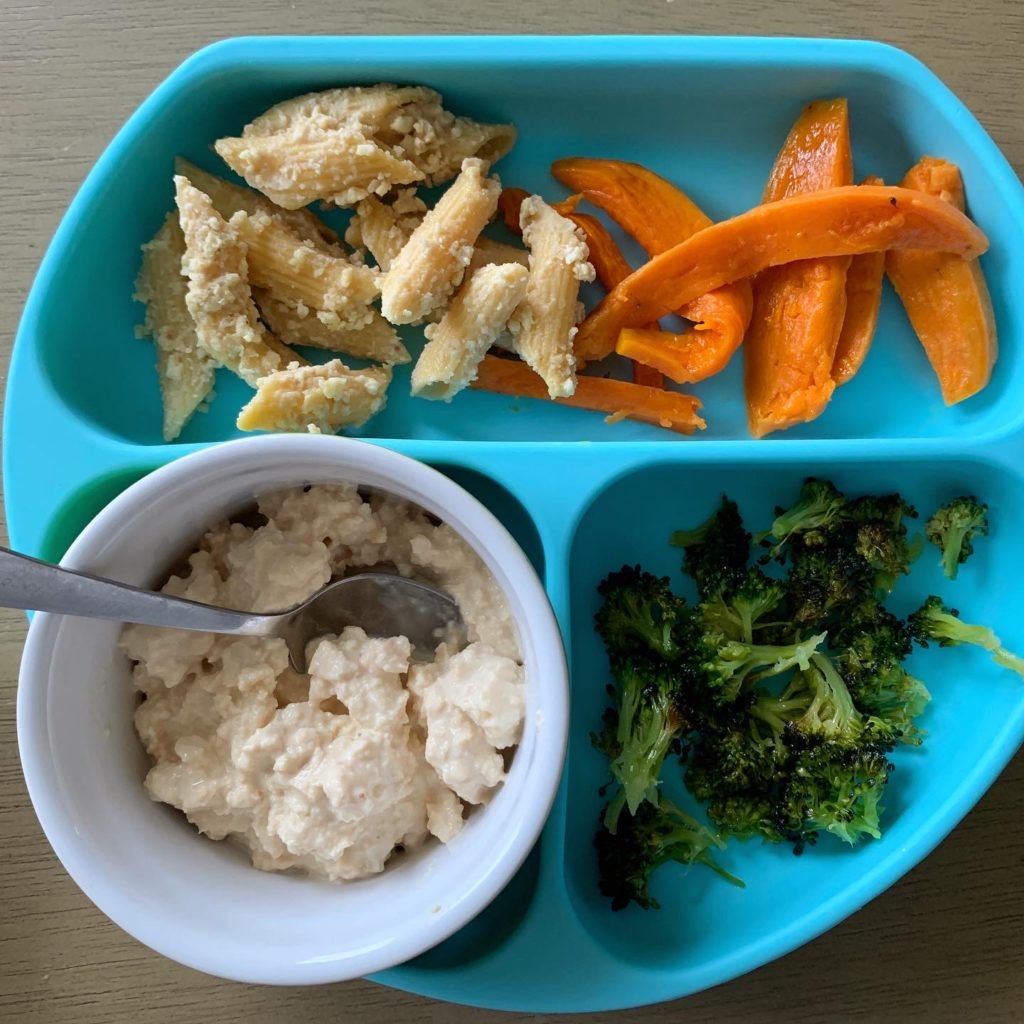
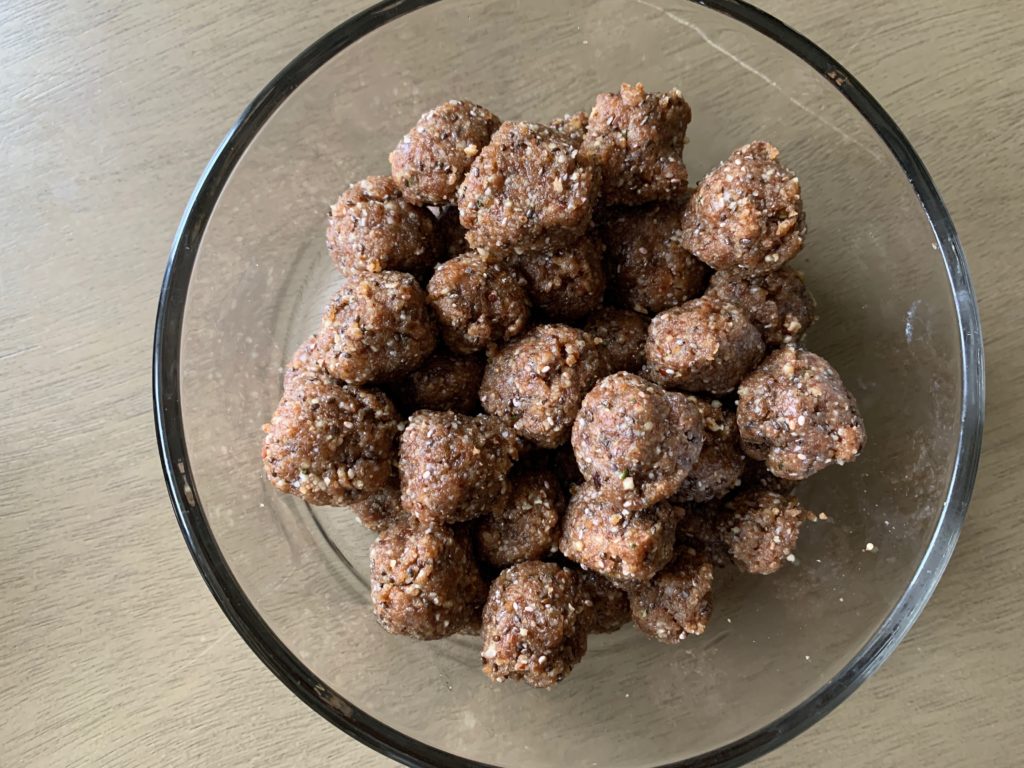
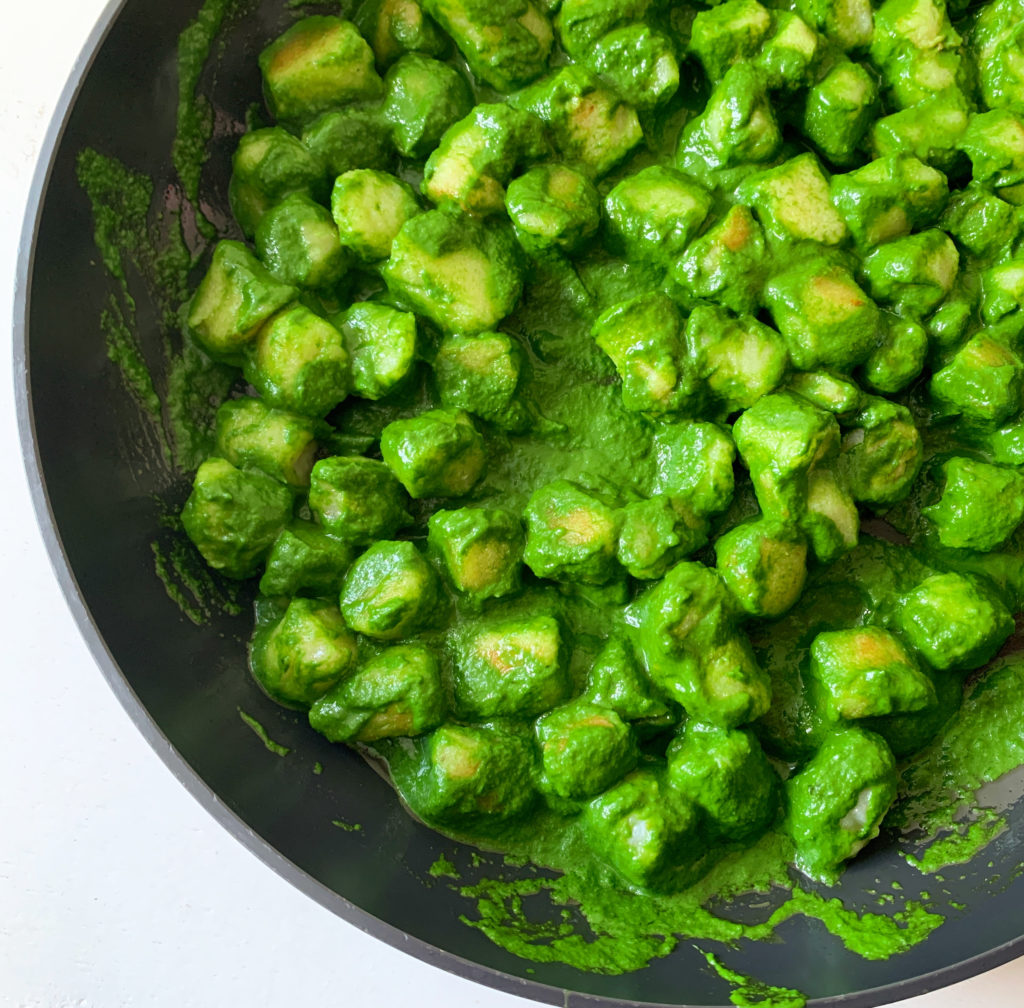
TRUST YOUR CHILD is the single most important lesson I take from Sattyr’s teachings. I had to erase all of the dietitian nonsense in my head as far as what nutrients and what portions my daughter needed and let her own appetite be the guide. Just like adults, the energy needs of kids varies. Kids actually know when they are hungry and full and we lose that sense as we age and are overloaded with giant restaurant portion sizes and mixed messages from the media. Once I was really able to realize this, my worry over her not eating “enough” completely vanished. I did my job by providing her with food and the rest is up to her.
DON’T PRESSURE. This means no negative or positive pressure. Just let them do their thing while they’re eating and avoid saying things like, “Just try one bite,” “If you eat this, then you can have _____, ” or even “Great job for eating ____.” Eating should be a normal event. (Full disclosure, I am still working on this… why is it so hard not to say “try this”?!!?). If you put vegetables, bread and meat on their plate and all they eat is bread, just leave it at that. With repeated exposure to new foods, eventually they will try the other items but the longer you push them to do so, the longer they might resist.
BE PERSISTANT. The worst thing is to see your child cry. When Clementine cries, literally every cell in my body aches. I want to do anything I can to make it stop and I know that by giving her cheese or milk or whatever she will stop crying. But this is setting us all up for an unhealthy future on many accounts. Persistance is key in acceptance of new foods. Some kids really do need to feel comfortable with a new food by seeing it many times before trying it. I think it took about 8 months of repeated exposure to broccoli before my daughter would even try it. It’s now one of her favorites.
GET YOUR KID INVOLVED. Whether it’s picking something at the grocery store or from the garden, helping to press start on the food processor or stirring/licking the bowl clean or even just hanging out in the kitchen, the more your child is on board with the process the more on board with eating they will be. Spend time in the store, garden and kitchen telling them about the ingredients and the cooking process. Let them taste things along the way and ask them what they are experiencing.
MODEL HEALTHY EATING BEHAVIOR. Sit and eat with your child at mealtimes. Enjoy a wide variety of healthy foods and don’t label any foods as “good” or “bad.”


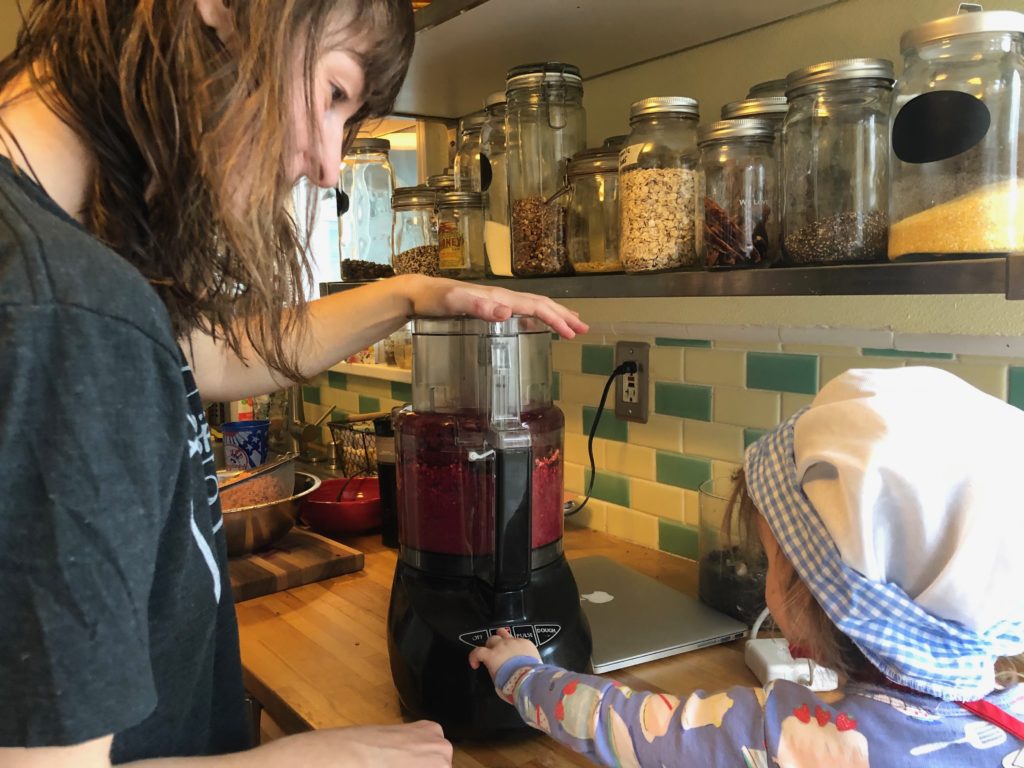
Once better eating behaviors are established, you can fine tune the nutrient content of what you are offering. Boost the nutrient value of foods (i.e. offering chickpea pasta rather than pasta made from white flour; adding super greens pesto into scrambled eggs). Work with what they like and try to change it up a bit to make it more nutrient dense. Don’t bother “sneaking” vegetables into food. There is a difference between boosting nutrient quality and sneaking. Adding pureed spinach to brownies is sneaky; no one knows they are there. Adding spinach pesto to eggs is obvious. Sneaking gets you nowhwere as far as acceptance of new foods and changing behaviors. Kids will never learn to accept and like a new food if they don’t know it’s there. Putting a food on their plate, even if it goes untouched for several attempts may seem futile but it’s actually an important step. If you are worried about vitamin deficiencies, I would recommend a multivitamin rather than taking all of the time and effort to sneak vegetables into foods.
I could go on and on and on about this topic but I believe I’ve covered the main points. I am including pretty much all of the recipes for foods Clementine eats and enjoys regularly, as well as a list of convenience products I purchase for her. We still have a ways to go and we still struggle often but this list is vastly longer than it was 6 months ago. This list may not work for your kiddo; they may have a totally different palate. Hopefully you find one or two things helpful on the list. (Please excuse any formatting issues, shorthand in instructions and lack of sourcing; these are my own notes and I’m sharing with you a rough/unedited version). If you need any more help at all with recommendations specific to your family, please reach out to schedule an appointment by emailing me at olivia@nourishnorthwest.com. I am here for you!!!!

Protein Power Squares
Ingredients:
1/2 cup walnuts
2 Tbsp chia seeds
2 Tbsp hemp seeds
2 Tbsp flax seeds
1/2 cup pumpkin seeds
pinch of salt
pinch of cinnamon (optional)
2 Tbsp almond butter
1 cup dates, pitted
coconut oil, optional and as needed
Instructions:
Throw the dry ingredients in your food processor and pulse. Then add the dates and almond butter and process until everything it starts to stick together. If too dry, add more dates or coconut oil. Press into an 8×8 pan and cut into several small squares. Refrigerate for storage.
Basic Overnight Oats
Ingredients:
2 medium bananas, mashed with a fork
2 Tbsp chia seeds, ground flax or a combo of both
1/2 teaspoon cinnamon
1 cup rolled oats
1 tsp vanilla extract
1 ½ cups light coconut milk, or any other milk of choice
Directions:
- In a small bowl, mash the banana until almost smooth. Now stir in the chia seeds and cinnamon until combined.
- Stir in the oats, coconut milk, and vanilla. Cover and refrigerate overnight, or a minimum of 2 hours.
Variations:
- Chocolate Peanut Butter Oats: Add 2 Tbsp peanut butter and 1 Tbsp unsweetened cocoa powder
- Golden Milk Oats: Add ½ Tbsp turmeric
- Yogurt oats: Replace ½ cup of the milk with yogurt of choice
- Apple cinnamon: Stir 1/4 cup applesauce into the oats in place of 1/4 cup milk
Apple Muffins
INGREDIENTS
- 1 3/4 cup whole wheat flour
- 1 ½ teaspoons baking powder
- 1 teaspoon ground cinnamon
- ½ teaspoon baking soda
- ½ teaspoon salt
- 1 cup grated apple
- ⅓ cup extra-virgin olive oil
- 1/4 cup of raisins, soaked for 10 minutes in 1/4 cup water and then blended in the food processor
- 2 flax eggs (dissolve 2 Tbsp ground flax in 6 Tbsp water and let sit for 10 minutes)
- ½ cup coconut milk
- 1 Tbsp apple cider vinegar
- ½ cup applesauce
- 1 teaspoon vanilla extract
INSTRUCTIONS
- Preheat oven to 425 degrees Fahrenheit. If necessary, grease all 12 cups on your muffin tin with butter or non-stick cooking spray.
- In a large mixing bowl, combine the flour, baking powder, cinnamon, baking soda and salt. Blend well with a whisk. Add the grated apple (if it is dripping wet, gently squeeze it over the sink to release some extra moisture). Stir to combine.
- In a medium mixing bowl, combine the oil and blended raisins and beat together with a whisk. Add the flax eggs and beat well, then add the coconut milk, apple cider vinegar, applesauce and vanilla and mix well.
- Pour the wet ingredients into the dry and mix with a big spoon, just until combined (a few lumps are ok). The batter will be thick, but don’t worry! Divide the batter evenly between the 12 muffin cups. Bake muffins for 13 to 16 minutes, or until the muffins are golden on top and a toothpick inserted into a muffin comes out clean.
- Place the muffin tin on a cooling rack to cool. If you have leftover muffins, store them, covered, at room temperature for up to 2 days, or in the refrigerator for up to 4 days. Freeze leftover muffins for up to 3 months.
Whole Wheat Blueberry Ginger Pancakes
Ingredients:
1 1/4 cups whole wheat flour
2 tsp baking powder
1 Tbsp ground flax, dissolved in 3 Tbsp water
1 1/4 cups milk of choice
1/2 tsp salt
1 tsp cinnamon
1/2 tsp ground ginger
1/2 cup frozen berries.
Coconut oil/butter for frying
Preparation:
Mix all ingredients together and drop by the quarter cup onto an oiled skillet. Cook until bubbles form and then flip and cook a few more minutes.
Banana Bread
Ingredients
4 ripe mashed bananas
3/4 cup coconut flour
5 eggs
1 tsp cinnamon
1 tsp vanilla
1 tsp baking soda
1/4 tsp salt
Instructions
Preheat oven to 350 and butter a loaf pan. Mix all ingredients together in a bowl. Pour into pan and bake for 45 minutes. Let cool, slice and enjoy!
Chocolate Pudding
Ingredients:
- 3/4 cup packed avocado (from 1 medium avocado)
- 1/4 cup unsweetened cocoa powder
- ½ cup pitted dates, soaked in ½ cup water
- 2 tablespoons unsweetened almond milk
- 1 tablespoon natural smooth roasted almond butter
- 1/2 teaspoon pure vanilla extract
For serving:
- Fresh berries or crumbled dehydrated berries
- Hemp seeds
Directions:
- Add the avocado, cocoa powder, dates, milk, almond butter and vanilla to a food processor (Process until super smooth, stopping to scrape down the side of the bowl as needed.
- Spoon into an airtight container, cover, and chill for 1 to 2 hours, or simply enjoy immediately at room temperature.
- Portion into shallow bowls and top with toppings of choice. Leftovers can be stored in an airtight container in the fridge for 1 to 2 days.
Oatmeal Almond Butter Cookies
Makes: 1 dozen
Ingredients
1 cup rolled oats, divided
1 teaspoon ground cinnamon
1/4 teaspoon ground nutmeg
1 teaspoon baking powder
1/4 teaspoon fine sea salt
1/2 cup golden raisins, soaked in warm water at least 10 minutes, drained and liquid reserved
1/2 cup almond butter
1 teaspoon pure vanilla extract
1/2 cup dark raisins
Directions
Preheat the oven to 350°F. Line a baking sheet with parchment paper. Pulse 3/4 cup of the rolled oats in a food processor until finely ground. In a large bowl, whisk oat flour with cinnamon, nutmeg, baking powder and salt until combined. Place soaked golden raisins and 1/4 cup soaking liquid in the food processor. Process until smooth. Add almond butter and vanilla. Purée until creamy. Combine raisin mixture with dry ingredients and add dark raisins and remaining 1/4 cup rolled oats. Mix thoroughly to combine until all of the oat flour is absorbed.
Drop heaping teaspoons of dough onto the prepared baking sheet, spacing each cookie about 1-inch apart. Gently flatten each cookie with the back of a spoon. Bake the cookies for 10-12 minutes, or until the bottoms are lightly browned.
Roasted Beet and Miso Dip
Ingredients:
3 medium sized beets, scrubbed
1 Tbsp miso
1 Tbsp olive oil, plus more as needed
Instructions:
Preheat oven to 400 degrees. Slice of the root end of the beets and wrap them all together in an aluminum foil packet. Drizzle with a tiny bit of oil to coat. Roast 45 minute-an hour, or until fork tender. Let cool just enough so you can handle them and slip the skins off with your hands. Roughly chop and place in a food processor with remaining ingredients, adding more oil as needed for a smooth consistency.
Polenta
INGREDIENTS
1/2 cup dry polenta
2 cups water
1/2 teaspoon salt
Optional: cashew parm
INSTRUCTIONS
- Bring water to a boil, add polenta and salt. Lower heat and continue to stir polenta as it thickens. On the lowest heat possible, continue to stir occasionally and let polenta cook for about 20 minutes (longer if you want the flavor to develop more). Add desired amount of cashew parm at the end and stir to combine.
Cashew Parm
Ingredients:
1 cup cashews
1 tbsp nutritional yeast
1 tsp garlic powder
1 tsp salt
Preparation:
Pulse everything together in the food processor until well combined and a fine powder texture is reached.
Super Green Pesto
Ingredients
2 cups spinach, kale, chard, carrot tops or any other green
3 tablespoons olive oil
2 tablespoons lemon juice
2 tablespoons walnuts, pumpkin seeds, hemp seeds or almonds
1 Tbsp miso
Preparation
Add all ingredients to a blender and blend until smooth, adding more oil if necessary. Store in an airtight container for up to a week.
Scrambled Eggs with Pesto
Ingredients:
Butter
2 eggs
2 Tbsp milk of choice
3 Tbsp super green pesto
Preparation:
Heat nonstick skillet over medium heat. Add enough butter to coat. Whisk eggs and milk together and add to the pan. Drop in pesto by the spoonful. Let eggs cook about 3 minutes, until bubbly and edges are starting to firm. Scramble with a rubber spatula to evenly distribute pesto. Serve warm.
Green Dream Smoothie
Preparation: Blend the cashews and water for 1 to 2 minutes to make cashew milk. Add in the other ingredients, except coconut water, and blend until rich and creamy. Blend in coconut water to reach desired consistency.
Very Berry Smoothie
1 ½ cups frozen mixed berries(blackberries, raspberries, strawberries, blueberries; about 6 ounces)
⅔ cup light coconut milk
1 banana (fresh or frozen)
1 tsp chia seeds
2 tsp hemp seeds
1 Tbsp almond butter
1 teaspoon fresh lime juice
⅛ teaspoon cinnamon, more to taste
Preparation
Combine all ingredients together in a blender and blend until smooth
Chocolate Protein Smoothie
1 Tbsp unsweetened cocoa powder
1 Tbsp hemp seeds
2 medjool dates, pitted and chopped
1 small frozen banana
1 ½ cups almond milk
1 Tbsp almond butter
Blend all ingredients together until smooth.
Citrus Sunshine Smoothie
Ingredients
2 small navel oranges, peeled
1 frozen banana, slightly thawed (33 seconds in the microwave makes it easy to peel)
1 tsp freshly grated ginger (use a Microplane grater)
1/4 tsp freshly grated turmeric or turmeric powder
1/2 cup raw cashews
1/4-1/2 cup light coconut milk
1 medjool date
Preparation
Blend all ingredients in a blender or food processor until smooth. If the smoothie is too thick, add some coconut milk, or water.
Spiced Almond Smoothie
- 2 large frozen bananas
- 2 Tablespoons almond butter
- 2 Tablespoons ground flaxseeds
- 1 medjool date, pitted and roughly chopped
- a few drops of almond extract (optional)
- pinch of ground cinnamon
- pinch of ground nutmeg
- 1 1/3 cups light coconut milk
- Place all the ingredients into a high speed blender and whirl away until smooth and creamy. Taste test and adjust flavors as needed.
Butternut Squash Risotto
INGREDIENTS
- 3 tablespoons olive oil, divided
- 1 small yellow onion, chopped
- 2 cloves garlic, pressed or minced
- 4 cups (32 ounces) vegetable broth, divided
- 1 cup water
- 1 ½ cups brown arborio/short-grain brown rice
- 1 small butternut squash (about 2 pounds), peeled and sliced into ½” cubes
- 1 cup freshly grated Parmesan cheese* (about 2 ½ ounces)
- ½ cup dry white wine, optional
- 3 tablespoons unsalted butter, diced
- 1 teaspoon salt, more to taste
- Freshly ground black pepper, to taste
- Pinch red pepper flakes, to taste
INSTRUCTIONS
- To prepare: Place your oven racks in the lower third and upper third positions (we’re going to bake the risotto on the middle rack and roast the squash on the upper rack at the same time), then preheat oven to 375 degrees Fahrenheit. Line a large, rimmed baking sheet with parchment paper for the butternut squash. Reserve 1 cup broth from your container and set it aside for when the risotto is out of the oven.
- Heat 1 tablespoon olive oil in a medium-to-large Dutch oven over medium heat until shimmering. Add onion and a pinch of salt. Cook, stirring occasionally, until softened and turning translucent, about 5 minutes. Add the minced garlic and cook until the garlic is fragrant, 1 to 2 minutes.
- Add 3 cups broth and 1 cup water, cover, and bring to a boil over medium-high heat. Remove from heat and stir in the rice. Cover the pot and bake on the lower rack until rice is tender and cooked through, about 65 to 70 minutes. It will seem pretty dry when you take off the lid, but don’t worry!
- Immediately after placing the pot of risotto in the oven, toss the cubed butternut with 2 tablespoons olive oil on your lined baking sheet. Sprinkle with salt and some freshly ground black pepper and arrange the butternut in a single layer on the pan. Roast on the upper rack until the butternut is fork tender and the edges are deeply caramelized, tossing halfway. This took 55 to 60 minutes for me, but start checking for doneness around 40 minutes.
- Carefully remove the Dutch oven from the oven. Remove the lid and pour in the remaining cup of broth, the Parmesan, wine and butter. Stir vigorously for 2 to 3 minutes, until the rice is thick and creamy. Stir in the salt, a generous amount of pepper and a pinch of red pepper flakes.
- Stir in the roasted butternut. Taste and add more salt and/or pepper, as needed. Divide the risotto into bowls.
Salmon Rice Bowls
Serves: 4
INGREDIENTS
Rice and seasonings
- 2 cups brown short-grain rice, rinsed well
- 3 tablespoons rice vinegar
- 1 ½ teaspoons tamari
- 1 tablespoon cane sugar
- ½ teaspoon salt
Salmon
- 1 pound salmon fillet cut into 4 thin portions (skin on is fine)
Teriyaki Sauce
- 3/4 cup tamari
- 3/4 cup Mirin (rice wine)
- 1 Tbsp cane sugar
- juice of 1 lime
- 1 teaspoon finely minced garlic (optional)
- 1 teaspoon finely minced ginger (optional)
Everything else
- Several sheets of Seaweed Snacks
- 2 large carrots, cut into matchsticks
- 1 avocado, sliced into long strips
- 1 small cucumber, cut into matchsticks
- Recommended garnishes: sesame seeds (preferably black
- Optional spicy mayo sauce (mix 1/4 cup mayo with 1 tsp sriracha and 1 tsp tamari- leave out sriracha id kiddos are sensitive to spice)
INSTRUCTIONS
- To cook the rice: Bring a large pot of water to boil. Once the water is boiling, pour in the rinsed rice and give it a stir. Boil the rice for 30 minutes, then turn off the heat and drain the rice. Return the rice to the pot and cover the pot. Let the rice steam for 10 minutes. Remove the lid and fluff the rice with a fork.
- To prepare the rice seasoning: In a small saucepan over medium heat, combine the rice vinegar, tamari, sugar and salt. Warm the mixture, stirring often, until the sugar dissolves. Remove from heat and toss with rice once it’s done steaming.
- Make the teriyaki sauce: In a small saucepan bring tamari, mirin, lime juice, sugar, garlic (if using) and ginger (if using) to a gentle boil. Lower the heat and simmer, uncovered, until slightly thickened, about 10 minutes. Remove from heat and set aside to cool.
- Cook the salmon: Preheat oven to broil and set the rack 8 inches from the top. Place salmon skin-side down on a foil-lined pan. Brush salmon with some teriyaki sauce and cook for four minutes under the broiler. Pull salmon out of the oven and brush more teriyaki sauce on top. Return to the oven and cook for 1-3 minutes more, to your desired doneness. Better to undercook it slightly as it will continue to cook a bit even after it’s out of the oven. Remove from oven.
- Divide the rice between four bowls. Top with carrots, avocado and cucumber. Add salmon, sprinkle with sesame seeds and seaweed. Drizzle with teriyaki sauce and optional spicy mayo.
Red Lentil Dal
Ingredients:
For the dal:
- 1 heaping tablespoon (20 mL) virgin coconut oil or olive oil
- 2 cups diced sweet potatoes
- 2 cups diced cauliflower
- 1/2 cup (100 g) uncooked red lentils
- 1/2 cup (125 mL) water, plus more if needed
- 1 (14-ounce/398 mL) can diced tomatoes
- 1 (14-ounce/398 mL) can light coconut milk
- 1 1/2 teaspoons (7.5 mL) garlic powder
- 1 1/2 teaspoons (7.5 mL) minced onion**
- 1 tablespoon (15 mL) good curry powder, or to taste***
- ¾ to 1 teaspoon fine sea salt, to taste
- Freshly ground black pepper, to taste
Directions:
- In a large pot, melt the coconut oil over low-medium heat.
- Add veggies into the pot and stir until combined. Increase heat to medium.
- Add in the rest of the ingredients (lentils, water, diced tomatoes [with juices], coconut milk, all the spices, salt, and pepper). Stir until combined.
- Increase heat to high and bring to a low boil. Reduce heat to medium and cook, uncovered, for 18 to 30 minutes, until the veggies and lentils are tender; the cook time will depend on the types of veggies you use, and their size. Stir the dal frequently while cooking, and reduce the heat if necessary to prevent it from sticking to the pot. (If you’re using potatoes, I suggest covering the pot while cooking since they don’t contain as much water to “cook off”. You may need to add more water to thin the mixture.)
Cauliflower Gnocchi with Kale Sauce
Ingredients:
2 packages Trader Joe’s Frozen Cauliflower Gnocchi
1 Tbsp butter
1 bunch of lacinato kale, ribs removed
2 Tbsp olive oil
2 cloves garlic, smashed
2 heaping Tbsp miso
Optional: Cashew Parm
Preparation:
In a large skillet, melt butter over medium heat. Add gnocchi in a single layer and cover with a lid. Cook until bottoms are browned, about 10 minutes. Remove lid and stir. Continue cooking another 10 minutes.
Meanwhile, bring a pot of water to boil. Add kale and cook for 3 minutes. Drain. In a small skillet heat olive oil and add garlic. Cook for 10 minutes, stirring frequently. To a high speed blender, add kale, garlic and oil and miso. Blend until smooth, adding small amounts of water as needed to reach a smooth consistency.
Add sauce to the skillet with gnocchi and toss to combine. Top with cashew parm if desired.
Matt’s Meatballs
Ingredients:
3 small carrots
1 zucchini
1 yellow onion
1 garlic clove
1/4 cup oat flour
1/4 cup ground flax
1/2 cup breadcrumbs
4 eggs
3 tbsp nutritional yeast
1 tbsp miso
3 dashes Worcestershire
2 pounds ground beef
salt and pepper
Preparation:
Preheat oven to 375 degrees. Add all veggies to a food process until liquefied. Set over a strainer and push to remove excess water. In a large bowl place remaining ingredients. Add drained veggies and mix with hand to combine. Form into 1 inch meatballs and place on a parchment lined baking sheet. Bake for 20 minutes, or until center is opaque. Freeze any leftovers in ziplock bags.
“Cheese” Sauce
- 1 1/4 cups (190 g) diced peeled yellow or red potatoes*
- Heaping 1/3 cup (55 g) diced peeled carrots*
- 2 tablespoons (6 g) nutritional yeast
- 2 tablespoons (30 mL) refined coconut or grapeseed oil**
- 2 1/2 tablespoons (37.5 mL) water
- 1 1/2 teaspoons (7.5 mL) fresh lemon juice
- 1/2 teaspoon fine sea salt
- 1 medium (4 g) garlic clove
- 1/2 teaspoon (2.5 mL) white wine vinegar
Place the potatoes and carrots in a medium pot and add water to cover. Bring to a boil over high heat, reduce the heat to medium, and simmer uncovered for 10 to 15 minutes, until fork-tender. Drain.
While the potatoes and carrots are simmering, add the nutritional yeast, oil, water, lemon juice, salt, garlic, and vinegar into a high-speed blender and set aside.
While the potatoes and carrots are simmering, add the nutritional yeast, oil, water, lemon juice, salt, garlic, and vinegar into a high-speed blender and set aside.
Roasted Broccoli and Sweet Potato Fries
Ingredients:
1 head of broccoli, chopped into bite sized florets
1 large sweet potato, peeled and sliced into long fry shapes
Olive oil
Salt
Preparation:
Preheat oven to 375. Line two baking sheets with parchment or Silpats. Add broccoli to one pan and sweet potatoes to another. Toss with Olive oil to coat and sprinkle with salt. Roast for about 30 minutes, or until fork tender, tossing a few times throughout cooking (the broccoli pan may be done first).
Sweet Potato Black Bean Quesadillas
Ingredients:
1 small sweet potato
1 can refried beans
1 cup shredded cheese
4 large whole wheat tortillas
Olive oil
Preparation:
Preheat oven to 400. Poke sweet potato all over with a fork. Bake for 45 minutes or until form goes in easily. Set aside to cool.
Spread 2 tortillas with refried beans and then mashed sweet potato. Add cheese. Top with second tortilla
Heat a small amount of olive oil (enough to coat pan) on a nonstick skillet. Cook 1 quesadilla at a time, for about 5 minutes each side.
Tofu Salad
Ingredients:
1 package firm organic tofu
2 Tbsp nutritional yeast
2 Tbsp tamari
¼ cup vegenaise
Preparation:
In a small bowl with a lid, mashed tofu with your hands. Add other ingredients and stir to combine. Store for 1 week.
Pasta with Butter and Cashew Parm
Ingredients:
1 box Banza chickpea pasta
3 Tbsp butter
3 tbsp cashew parm
Preparation:
Prepare pasta according to package directions. In a large skillet, melt butter. Add pasta and toss to coat. Add cashew parm, toss again and serve.
Convenience Foods from Trader Joe’s
- These Peanuts Go on a Date Bars
- Lara Bars
- Date and Nut Bites
- Crispy Crunchy Broccoli Florets
- Dehydrated fruit (strawberries, blueberries, apples)
- Bananas
- Organic Raisins
- Organic String Cheese
- Organic sliced turkey breast
- Salmon Burgers
- Veggie Burgers
- Chicken Sausage

